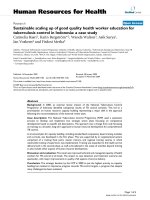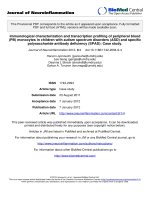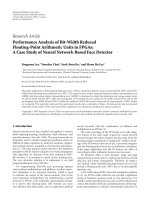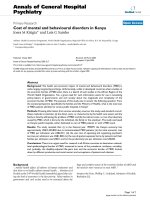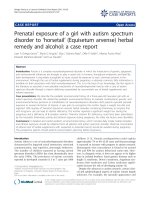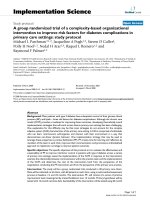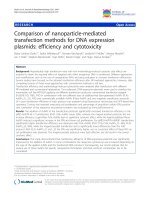Feasibility of parent‑mediated behavioural intervention for behavioural problems in children with Autism Spectrum Disorder in Nigeria: A pilot study
Bạn đang xem bản rút gọn của tài liệu. Xem và tải ngay bản đầy đủ của tài liệu tại đây (782.29 KB, 8 trang )
Bello‑Mojeed et al.
Child Adolesc Psychiatry Ment Health (2016) 10:28
DOI 10.1186/s13034-016-0117-4
Child and Adolescent Psychiatry
and Mental Health
RESEARCH ARTICLE
Open Access
Feasibility of parent‑mediated
behavioural intervention for behavioural
problems in children with Autism Spectrum
Disorder in Nigeria: a pilot study
Mashudat Bello‑Mojeed1,5*, Cornelius Ani2, Ike Lagunju3 and Olayinka Omigbodun4,5
Abstract
Background: Autism Spectrum Disorders (ASD) is a disabling and lifelong neuro-developmental disorder. Challeng‑
ing behaviours such as aggression and self injury are common maladaptive behaviours in ASD which adversely affect
the mental health of both the affected children and their caregivers. Although there is evidence-base for parentdelivered behavioural intervention for children with ASD and challenging behaviours, there is no published research
on the feasibility of such an intervention in sub-Saharan Africa. This study assessed the feasibility of parent-mediated
behavioural intervention for challenging behaviour in children with ASD in Nigeria.
Methods: This was a pre-post intervention pilot study involving 20 mothers of children with DSM-5 diagnosis of ASD
recruited from a Child and Adolescent Mental Health Service out-patient Unit. All the mothers completed five ses‑
sions of weekly manualised group-based intervention from March to April, 2015. The intervention included Functional
Behavioural Analysis for each child followed by an individualised behaviour management plan. The primary outcome
measure was the Aggression and Self Injury Questionnaire, which assessed both Aggression towards a Person and
Property (APP) and Self Injurious Behaviour (SIB). The mothers’ knowledge of the intervention content was the sec‑
ondary outcome. All outcome measures were completed at baseline and after the intervention. The mothers’ level of
satisfaction with the programme was also assessed. Treatment effect was evaluated with Wilcoxon Signed Rank Tests
of baseline and post-intervention scores on outcome measures.
Results: The children were aged 3–17 years (mean = 10.7 years, SD 4.6 years), while their mothers’ ages ranged from
32 to 52 years (mean 42.8 years, SD 6.4 years). The post intervention scores in all four domains of the APP and SIB were
significantly reduced compared with pre-intervention scores. The mothers’ knowledge of the intervention content
significantly increased post-intervention. The intervention was well received with the vast majority (75 %) of partici‑
pants being very satisfied and all (100 %) were willing to recommend the programme to a friend whose child has
similar difficulties.
Conclusions: Parent-mediated behavioural intervention is a feasible and promising treatment for challenging behav‑
iour in children with ASD in Nigeria. Behavioural intervention should be an integral component in scaling up services
for children with ASD in Nigeria.
Keywords: Autism Spectrum Disorder, Challenging behaviour, Functional behaviour analysis, Behavioural
intervention, Parent education
*Correspondence:
1
Child and Adolescent Mental Health Service Unit, Federal
Neuro-Psychiatric Hospital, Lagos, Nigeria
Full list of author information is available at the end of the article
© 2016 The Author(s). This article is distributed under the terms of the Creative Commons Attribution 4.0 International License
( which permits unrestricted use, distribution, and reproduction in any medium,
provided you give appropriate credit to the original author(s) and the source, provide a link to the Creative Commons license,
and indicate if changes were made. The Creative Commons Public Domain Dedication waiver ( />publicdomain/zero/1.0/) applies to the data made available in this article, unless otherwise stated.
Bello‑Mojeed et al. Child Adolesc Psychiatry Ment Health (2016) 10:28
Background
Parents of children with Autism Spectrum disorder
(ASD) face many challenges in caring for their affected
children. The burden is often disproportionately shouldered by mothers [1–3]. Autism Spectrum Disorder
(ASD) is a complex and heterogenous disorders with
qualitative impairments in social and communication
skills, rigid and obsessive interests, and a range of sensory
difficulties [4]. In addition to the core social and communication deficits in ASD, challenging behaviour such
as aggressive, self-injurious and disruptive problems are
common. The prevalence of challenging behaviour varies but reported to be as high as 94 % with aggressive or
self-injurious behaviour present in about 55 % of affected
children [3, 5, 6]. The presence of challenging behaviour
in ASD adversely affects the child, family and the wider
society [3, 7]. Challenging behaviour can be a source of
major threat to the safety of the affected child and others. It can limit the child’s life opportunities, increase his/
her risk of institutionalization and become an obstacle to
treatment of core symptoms of ASD. Affected children
are socially rejected, stigmatised, at risk of abuse and
retaliation from peers, staff and family members [7]. In
the absence of appropriate treatment, challenging behaviour in ASD could persist into adulthood with associated
developmental and lifelong consequences.
Challenging behaviour also increases the psychosocial
stress of care giving especially on mothers who bear a
disproportionate burden of care giving [1–3]. The role of
mothers as primary care givers places them in a unique
position in the delivery of intervention for children with
ASD [8, 9]. Involvement of mothers in intervention
for their children with ASD has a potential benefit of
improved child outcome, reducing associated maternal/
family stress, improving care giving skill including identification of possible functions of the aggression [10–13].
Studies suggest that challenging behaviour in ASD
could serve a range of functions including a need for
attention, protest against unwanted events and access
to tangible items [14–16]. Although pharmacological
and non-pharmacological approaches are effective for
managing challenging behaviour in ASD, behavioural
interventions are considered first line [17]. Behavioural
interventions are relatively safe and cost effective compared with pharmacological treatments such as antipsychotics which can have intolerable debilitating side
effects [18]. A growing number of studies have demonstrated the benefit of behavioural intervention for challenging behaviour such as aggression in ASD [10, 19, 20].
Notably, studies have shown that as behaviour is influenced by contingencies in the environment, it is similarly
sensitive to alteration in such environmental contingencies [14]. Effective behavioural intervention offers
Page 2 of 8
important opportunity for improvement for both child
and the family caregiver [10, 19, 20].
Despite the good evidence-base for behavioural intervention in managing challenging behaviour in ASD, the
main treatment option in Nigeria and other sub-Saharan
African countries remains pharmacological [9, 21]. There
is virtually no published data on the feasibility of FBA
for children with ASD in sub-Saharan Africa. Given the
high prevalence of challenging behaviour in ASD and
its adverse effect on the affected child, caregiver and the
wide society, it is important that appropriate interventions are put in place to identify and address behavioural
problems in affected children in sub-Saharan Africa [22,
23]. Given the huge socio-economic, cultural and demographic differences between developed countries and
LMICs like Nigeria, it cannot be assumed that interventions that are effective in developed countries would be
equally effective in settings such as Nigeria. This study
therefore assessed the feasibility of parent-mediated
behavioural intervention for challenging behaviour in a
clinical population of children with ASD in Lagos, South
West Nigeria.
Methods
Participants and sampling
The participants comprised children with a diagnosis of
autism spectrum disorder and their respective mothers. The inclusion criteria were children below the age of
18 years, with a history of aggressive and self-injurious
behaviour and attending the Neurodevelopmental Clinic
at Child and Adolescent Mental Health Service Unit
of Federal Neuro-Psychiatric Hospital (FNPH), Lagos,
Nigeria, and whose mothers gave consent. The neurodevelopmental clinic is a tertiary centre that receives referrals from other parts of the country.
Using sample size calculation described by Wade [24],
16 mothers was identified as adequate to detect a postintervention difference of one standard deviation in outcome measures based on 5 % level of significance and
80 % power. The sample was increased to 20 account for
possible drop outs. We hypothesized such a large postintervention difference because the huge treatment gap
in Africa increases the likelihood that simple interventions can produce huge outcomes [25].
Measures
The instrument used for data collection comprised a
socio-demographic questionnaire, aggression and selfinjury questionnaire (ASIQ), knowledge of behavioural
management of aggression questionnaire (KBMAQ) and
client satisfaction questionnaire (CSQ). The instrument
was pre-tested on 10 mothers of children with ASD and
challenging behaviour outside the study population, and
Bello‑Mojeed et al. Child Adolesc Psychiatry Ment Health (2016) 10:28
found to be comprehensible and reliable for the population of children with ASD. Two weeks test retest reliability for the ASIQ and KBMAQ were excellent (r = 0.95,
p < 0.001; r = 0.94, p < 0.001 respectively). Cronbach
alphas are 0.86, 0.87, and 0.81 for ASIQ, KBMAQ, and
CSQ respectively.
The socio-demographic questionnaire obtained information on participants’ socio-demographic details such
as age, gender, marital status and level of education.
Aggression and self injurious behaviour questionnaire
(ASIQ) was adapted by the first author from Hyman
et al. [26] and Rojahn et al. [27]. The questionnaire has
two sections. The first section has 12 items that assess
aggressive behaviour against a person or property (APP
section). The second Section has 10 items that measure self-injurious behaviours (SIB section). Each item
on the APP and SIB sections was scored on four scales:
a five-point frequency scale (never = 0, monthly = 1,
weekly = 2, daily = 3, and two or more times daily = 4),
a four-point severity scale (0 = no problem, 1 = slight
problem, 2 = moderate problem, and 3 = severe problem), a five-point duration scale (1 = <1 min, 2 = <5 min,
3 = <15 min, 4 = <1 h, and 5 = 1 h or more), and finally
a five-point need for physical restraint scale (0 = never,
1 = at least once a month, 2 = at least once a week, 3 = at
least once a day, and 4 = at least once an hour while
awake). A total score was obtained for each item by summing the scores on all the four domains for that item: frequency, severity, intensity and physical restraint domains.
On this instrument a higher score indicate a more difficult or severe challenging behaviour. The items were
completed at baseline and post-intervention by a trained
interviewer who was blind to the aim of the intervention.
Knowledge of behavioural management of aggression questionnaire (KBMAQ) is a 12-item instrument
designed by the first and second authors to assess the
mothers’ knowledge of the content of the sessions pre
and post-intervention. Face validity of this measure was
assessed through peer review. Examples of items on the
measure include, “For a child who is unable to explain
things, the purpose of a challenging behaviour can be
identified by examining what he/she was doing before
the behaviour started”, “Understanding how a challenging behaviour ends can help to identify how to prevent
it in future”. Each item on the measure was scored on a
scale of “true”, “false” and “don’t know”. One mark was
given for a “true” response (correct answer) and a zero
for either a “false” (incorrect answer) or “don’t know”
option. The total possible score on this measure ranged
from 0 to 12 with a higher score indicating a higher level
of knowledge.
The Client satisfaction questionnaire consists of 8
questions modified from Attkinson and Greenfied [28],
Page 3 of 8
to assess the mothers’ satisfaction with the programme
post-intervention. Each question is scored on a Likert
scale of 1–4 with a total score ranging from 8 to 32. On
this instrument, a higher score indicates a higher level
of satisfaction. The instrument has been found to be
reliable for use in Nigeria with a Cronbach alpha of 0.81
[29].
The study instruments were translated into Yoruba by
a Yoruba speaking psychiatrist and a linguist. The back
translation was performed independently by another psychiatrist and another linguist. This back translation was
then compared with the original translation by an independent panel and confirmed to be satisfactory before
use.
The intervention
The Behavioural intervention manual for aggression
in ASD used for this study was adapted by the second
author from previous works including Durand and Crimmins [30] and Iwata and Dozier [31]. The intervention
was delivered by the first author who is a consultant psychiatrist with training in behavioural interventions in
ASD. The other authors provided supervision. The intervention was delivered in a group format as this is likely to
be more cost-effective in a low and middle income country (LMIC) such as Nigeria.
The behavioural intervention comprised five workshop-styled sessions that includes interactive group
discussion and problem solving. The first session introduced concepts such as ASD, associated impairments
and aggression in ASD. The second session explained the
basic principles of functional behaviour analysis (FBA)
for aggression in ASD and identification of triggers.
The third session focussed on the principle of contingency management such as use of reward to encourage
more adaptive behaviours and non-physical consequences to reduce aggression. The fourth session was a
further extension/reinforcement of the issues covered
in the second and third sessions. This helped to embed
the concepts and address practical issues arising from
each mother’s use of the strategies with their own children. The fifth session was a review of the four previous
sessions.
Study procedure
The study procedure was in three stages. The first stage
involved making or re-confirming a diagnosis of Autism
Spectrum Disorder. The first author, a Consultant Psychiatrist in Child and Adolescent Mental Health, carried out
a psychiatric assessment on every child with a previous
diagnosis of ASD and any new patients suspected to have
the disorder. The clinical diagnosis of ASD was based on
DSM-5 criteria [4].
Bello‑Mojeed et al. Child Adolesc Psychiatry Ment Health (2016) 10:28
Secondly, the mothers of children with ASD, who met
the inclusion criteria, were interviewed individually in
separate rooms. The socio-demographic questionnaire,
aggression questionnaire and knowledge questionnaire
were administered to the mothers by a trained interviewer who was blind to the study hypotheses. Subjects
who were unable to communicate in English language
were interviewed in Yoruba language. The instruments
were translated from English into Yoruba Language to
facilitate easy comprehension by participants who were
unable to communicate in English Language.
The third stage involved delivery of the five sessions
of intervention. This was done weekly in a group format
with ten mothers in each group. In between sessions,
mothers were contacted via telephone calls and short
message service (SMS) to assist with problem-solving
and to remind them of the date of next intervention session. The 20 mothers attended all the intervention sessions and completed all the outcome measures. Post
intervention assessments were conducted a week after
the final session. The post-intervention measures were
administered by the same trained interviewer who was
still blind to the study hypotheses.
Ethical considerations
The study was approved by the Ethical and Research
Committee of the Federal Neuro-Psychiatric Hospital,
Yaba, Lagos. Informed consent was obtained from all
the mothers after an explanation of the aim of the study.
Informed consent of fathers was also obtained; either
directly from those fathers who accompanied the child
to the clinic or indirectly over the phone. Assent was
obtained from children with ASD who were judged to be
competent.
Data analysis and management
Data were analysed with Statistical Package for Social
Sciences software version 21. Categorical socio-demographic variables and types of aggressive behaviour were
presented as frequencies and proportions. Continuous measures such as age, APP, SIB, and KBMAQ were
presented as mean and standard deviations. Differences
in pre and post-intervention scores on non-normally
distributed outcome measures (APP and SIB) were analysed with Wilcoxon signed-rank test and paired t test for
KBMAQ.
Results
A total of 20 children with a diagnosis of Autism Spectrum Disorder (ASD) and their respective mothers participated in this study. All the children with ASD had
aggressive and self injurious behaviour.
Page 4 of 8
Table 1 shows the socio-demographic characteristics of
the children with ASD and their mothers. The children
were aged 3–17 years (mean = 10.7 years, SD 4.6 years),
while their mothers’ age ranged from 32 to 52 years (with
a mean age of 42.8 years, SD, 6.4). There was a male preponderance (65.0 %) among the children in the sample.
55 % of the children were in special schools that were
non-specific for autism while almost a third (30.0 %) was
out of school (Table 1). 85 % of the mothers were currently married, and a similar proportion had a minimum
of 12 years formal education (Table 1).
Of the measured 12 items on aggressive behaviour
towards a person or property (APP) category of ASIQ,
destructiveness had the highest rate of 65.0 %, followed
by hitting and pulling with a rate of 55.0 %. Of the 10
items measured on the self injurious behaviour (SIB) category of ASIQ, self-hitting with hand was the most frequent at a rate of 50.0 %, followed by self-biting (45.0 %).
Tables 2 and 3 show Wilcoxon signed-rank test for the
differences in the pre and post intervention scores on the
Table 1 Socio-demographic characteristics of study participants (children with ASD and mothers) N = 20
Variable
Frequency
(n)
Percentage
(%)
Child gender
Male
Female
13
65.0
7
35.0
Child’s education
Special school
11
55.0
Out of school
6
30.0
Mainstream school
3
15.0
Birth order
First child
8
40.0
Middle child
5
25.0
Last child
7
35.0
Marital status
17
85.0
Separated/divorced
Currently married
2
10.0
Widowed
1
5.0
15
75.0
5
25.0
Family setting
Monogamous
Polygamous
Mother’s education
6 years of formal education
3
15.0
12 years of formal education
5
25.0
12
60.0
Tertiary education
Religion
Christianity
Islam
15
75.0
5
25.0
Bello‑Mojeed et al. Child Adolesc Psychiatry Ment Health (2016) 10:28
Page 5 of 8
Table 2 Differences between pre and post intervention outcome measures for aggressive behaviour towards a person or
property in children with ASD N = 20
Variable
APP frequency
Pre-intervention
Post-intervention
Median (interquartile range)
Median (interquartile range)
11.0 (11.0)
9.0 (13.0)
7.0 (8.0)
6.5 (8.0)
APP severity
APP duration
7.5 (9.0)
5.0 (10.0)
APP need for physical restraint
8.5 (7.0)
5.5 (8.0)
32.5 (30.0)
26.5 (36.0)
APP total score
Wilcoxon rank
−2.560
−2.507
−2.825
−3.346
−3.519
p
0.010*
0.012*
0.005*
0.001*
<0.001*
* Significant at p < 0.05
Table 3 Differences between pre and post intervention outcome measures for self-injurious behaviour (SIB) in children
with ASD N = 20
Variable
SIB frequency
SIB severity
Pre-intervention
Post-intervention
Median (interquartile range)
Median (interquartile range)
11.0 (12.0)
10.0 (11.0)
7.0 (7.0)
6.5 (6.0)
SIB duration
5.5 (6.0)
5.0 (6.0)
SIB need for restraint
7.5 (10.0)
7.0 (8.0)
33.0 (30.0)
31.0 (30.0)
SIB total score
Wilcoxon rank
−2.967
−2.414
−2.232
−2.549
−2.714
p
0.003*
0.016*
0.026*
0.011*
0.007*
* Significant at p < 0.05
APP and SIB measures. There was a statistically significant reduction in the post intervention scores on all the
four domains of aggression towards APP compared to
pre-intervention scores (Table 2).
The self-injurious behaviour category showed a statistically significant decrease in the post-intervention SIB
mean scores compared with pre-intervention scores in all
the four domains (Table 3).
The mother’s post-intervention knowledge of the subjects covered in the intervention was statistically significantly higher than their pre-intervention knowledge
(Table 4).
The client satisfaction questionnaire showed that
the intervention was very well received by the mothers. Two-third (40 %) of mothers rated the intervention
programme as good while 60 % rated it as excellent. The
majority (85 %) of mothers endorsed that the programme
helped them cope a lot better with their child’s problem
Table 4 Differences in the pre and post intervention mean
scores on knowledge of mothers on behavioural management of aggression in ASD N = 20
Variable
Knowledge
*
Pre-intervention
Post-intervention
Mean
(SD)
Mean
(SD)
7.90 (2.57)
Significant at p < 0.05
11.80 (0.41)
Mean difference
(SD)
1.40 (1.19)
t
p
5.272 <0.001*
behaviour. 80 % of the mothers were very satisfied, and all
(100 %) would recommend it to a friend whose child has
a similar problem.
Discussion
Studies from developed countries have shown that
behavioural problems in ASD can be effectively managed
with parent-delivered behavioural interventions [12, 32,
33]. This feasibility study suggests that parents of children with ASD and challenging behaviour in resourcepoor settings like Nigeria can understand and use
behavioural intervention to reduce disruptive behaviour
in their children. To our knowledge, this is the first study
in sub-Saharan Africa to show that a behavioural intervention for challenging behaviour in ASD based on FBA
is feasible in this part of the world.
This study adds to the existing evidence of the potential
benefit of parent-mediated behavioural intervention for
problem behaviour in ASD. For example, in a Canadian
study conducted in a community day-care centre over
12 weeks, Jocelyn et al. [12] taught 35 parents the use of
functional analysis to understand challenging behaviour
in children with ASD and developed treatment strategies for managing such behaviours. They found significant improvements in post test behavioural measures. In
another study using reinforcement, antecedent—based
techniques and environmental manipulations, Butler
and Luselli [34] demonstrated a reduction in aggression
Bello‑Mojeed et al. Child Adolesc Psychiatry Ment Health (2016) 10:28
to near zero level among children with autism aged
1–13 years. Similarly, Frea et al. [35] reported an immediate and rapid reduction in aggression in children with
autism and intellectual disability through the use of picture exchange communication system (PECS) while Mueller et al. [36] observed a decrease in aggressive behaviour
in children with ASD by active antecedent manipulation
of reinforcers. Braithwaite and Richdale [31] and Athens
and Vollmer [33] also used reinforcement-based strategies
in a behavioural intervention for aggressive behaviour and
documented a significant reduction in the rate of aggressive behaviour post intervention.
The finding of the present study is also in line with a
large scale randomized clinical trial, conducted by Bearss
et al. [37], among 180 children aged 3–7 years with ASD
and behavioural problems in the United States. The investigators randomized children and their mothers into two
groups to receive either parent training or education aimed
at examining the effect of either intervention on disruptive behaviour in their children with ASD. Bearss et al. [37]
reported a reduction in disruptive behaviour post behavioural intervention, especially in the parent training group.
These findings support the effectiveness of behavioural
programmes that include identification of the functions
of challenging behaviour, and developing a behavioural
plan that specifies strategies to alter the antecedents
and reduce the contingencies that increase the behaviour while enhancing those that terminate or reduce the
challenging behaviour. The robustness of this evidence
underlines its recommendation in guidelines for management of children with ASD [17].
However, while the principles of behavioural intervention based on FBA are now well established, putting
them into practice especially with parents with a priori
limited knowledge of ASD or behavioural psychology or
even basic literacy can be a challenge. Nonetheless, this
study shows that such an intervention is feasible even in
resource-poor settings like Nigeria, in so far as the programme is explained at a level accessible to parents. It
suggests that parents in these settings can understand it
and put the techniques into practice, and report significant reductions in their childrens’ challenging behaviour.
The study also suggests that the intervention was highly
acceptable to the parents with the vast majority being
very satisfied and all participants willing to recommend
it to a friend whose child has similar difficulties. The fact
that the improvements were reported with a relatively
short intervention of five sessions is particularly encouraging because brief interventions are more likely to be
feasible in resource-limited settings like Nigeria. The use
of a group format, which could be cheaper than individualised intervention in a poor resource setting, adds further to the feasibility.
Page 6 of 8
Another important observation from the study is that
about a third of the children were out of school and all
those in special schools were in settings not specialized
for the specific need of children with ASD. This is consistent with previous studies in the country [3, 38]. Omigbodun [38] found that 27.6 % of the children with ASD in
Ibadan, Nigeria were out of school due to lack of suitable
schools to meet their educational needs. Similarly, BelloMojeed et al. [3] reported that 41 % of Nigerian children with ASD had no access to formal education while
69 % of those in contact with educational setting were
out of school. These findings highlight the serious barriers encountered in accessing appropriate educational
placement for Nigerian children with ASD. One possible
explanation is that lack of skills in managing ASD-related
challenging behaviour may be preventing mainstream
schools from admitting children with ASD whose educational needs might otherwise be met within inclusive
educational settings. This suggests that extending behavioural interventions for managing aggression to Nigerian
teachers could improve access to education for the large
number of children with ASD who are currently without
any educational placement.
While the findings of this study are promising, they
need to be interpreted with some limitations in mind. The
main limitation is the lack of a control group. This means
that the improvements noted could be attributable to
other factors unrelated to the intervention such as regression to the mean, practice effect, attention, and or the
enthusiasm of the workshop leader. Similarly, lack of independent rating of outcomes means that the mothers may
have subconsciously reported positive outcomes to justify
the investment in time and energy they made to attend the
programme. However, the significant improvement in the
mothers’ knowledge of the themes covered in the intervention suggests that some of the benefits could be related
to the intervention. The relatively small sample size which
was also selected from a tertiary referral centre makes it
difficult to generalize the findings to the general population of children with ASD and aggression in Nigeria or
sub-Saharan Africa. The duration of the post-intervention
outcome assessment was short and this makes it difficult
to evaluate the long term effect of the intervention.
Conclusions
This study suggests that challenging behaviour in children with ASD in a resource-poor setting like Nigeria
could be significantly reduced with a brief (5 sessions)
behavioural intervention based on FBA delivered by
parents with the support of a professional. This suggests
that FBA-based behavioural intervention is feasible and
shows some promise as an effective treatment option for
reducing challenging behaviour in children with ASD
Bello‑Mojeed et al. Child Adolesc Psychiatry Ment Health (2016) 10:28
in Nigeria and other LMICs. Future studies in LMICs
should explore the efficacy of this intervention with randomised controlled trials using independently rated outcome measures with some masking. We recommended
that future studies use standardised outcome measures
with clinical cut-offs so that the clinical significance of
any changes can be identified.
Abbreviations
ABA: applied behaviour analysis; ABC: antecedent behaviour consequence;
APP: aggression towards a person or property; ASIQ: aggression and self
injurious questionnaire; APA: American Psychiatric Association; APP: aggres‑
sion against a person or property; ASD: Autism Spectrum Disorders; ASIQ:
aggression and self injurious behaviour questionnaire; CSQ: client satisfaction
questionnaire; DSM V: diagnostic and statistical manual of mental disorder
version v; FBA: functional behaviour analysis/assessment; FNPH: federal
neuro-psychiatric hospital; KBMAQ: knowledge on behavioural management
of aggression questionnaire; LMIC: low and middle income countries; NICE:
National Institute for Health and Clinical Excellence; PECS: picture exchange
communication system; SIB: self injurious behaviour; SMS: short message
service.
Authors’ contributions
All authors are involved in the conception and design of the study. MAB did
the statistical analysis and CA gave statistical assistance. MAB wrote the initial
draft of the manuscript. All authors read and approved the final manuscript.
Author details
1
Child and Adolescent Mental Health Service Unit, Federal Neuro-Psychiatric
Hospital, Lagos, Nigeria. 2 Centre for Mental Health, Hammersmith Hospital
Campus, Imperial College, London, UK. 3 Department of Pediatrics, Univer‑
sity College Hospital, Ibadan, Nigeria. 4 Department of Psychiatry, University
College Hospital, Ibadan, Nigeria. 5 Centre for Child and Adolescent Mental
Health, University of Ibadan, Ibadan, Nigeria.
Acknowledgements
We thank the children with ASD and their mothers that participated in this
study.
Competing interests
The authors declare that they have no competing interests.
Data availability
We would be happy to share our materials on request but we do not have the
technology to allow the data to be accessed remotely through a URL link.
Funding
This study is supported by the John D. and Catherine T. MacArthur Foundation
(Grant Number: 10-95902-000-INP) through the University of Ibadan Centre for
Child and Adolescent Mental Health (CCAMH).
Role of the funder
The funding body has no role in the design and conduct of the study; collec‑
tion, analysis and interpretation of data; preparation, writing and approval of
the manuscript, and decision to submit the manuscript for publication.
Received: 11 February 2016 Accepted: 18 August 2016
References
1. Lecavalier L, Leone S, Wiltz J. The impact of behaviour problems on car‑
egiver stress in young people with autism spectrum disorders. J Intellect
Disabil Res JIDR. 2006;50(3):172–83.
Page 7 of 8
2. Baker-Ericzen MJ, Brookman-Frazee L, Stahmer A. Stress levels and adapt‑
ability in parents of toddlers with and without autism spectrum disorders.
Res Pract Pers Sev Disabil. 2005;30:194–204.
3. Bello-Mojeed MA, Omigbodun OO, Ogun OC, Adewuya OA, Adedokun B.
The relationship between the pattern of impairments in autism spectrum
disorder and maternal psychosocial burden of care. Open access. Autism.
2013;1(1):4.
4. American Psychiatric Association. Diagnostic and statistical manual of
mental disorders, 5th edn. (DSM-V). Washington D.C: APA; 2013
5. McTiernan A, Leader G, Healy O, Mannion A. Analysis of risk factors and
early predictors of challenging behaviour for children with ASD. Res
Autism Spectr Disord. 2011;5:1215–22.
6. Kanne SM, Mazurek MO. Aggression in children and adolescents with
ASD: prevalence and risk factors. J Autism Dev Disord. 2011;41(7):926–37.
7. Matson JL, Mahan S, Hess J, Neal D. Progression of challenging behav‑
iours in children and adolescents with autism spectrum disorders as
measured by the autism spectrum disorder-problem behaviours for
children (ASD-BPC). Res Autism Spectr Disord. 2010;4:400–4.
8. Reichow B, Servili C. Taghi Yasamy M, Barbui C, Saxena S. Non-specialist
psychosocial interventions for children with intellectual disability or
lower-functioning autism spectrum disorders: a systematic review. PLoS
Med. 2013;10(12):e1001572. doi:10.1371/journal.pmed.10001572.
9. Bello-Mojeed MA, Bakare MO. Improving treatment of children with
autism spectrum disorder in low- and middle- income countries: the
role of non-specialist care providers. PLoS Med. 2013;10(12):e1001573.
doi:10.1371/journal.pmed.10001572.
10. Brookman-Frazee L, Stahmer A, Baker-Ericzen M, Tsai K. Parenting inter‑
ventions for children with Autism Spectrum Disorders: opportunities for
cross-Fertilization. Clin Child Fam Psychol Rev. 2006;9(3–4):181–200.
11. Steiner AM, Koegel LK, Koegel RL, Ence WA. Issues and theoretical
constructs regarding parent education for autism spectrum dis‑
orders. J Autism Dev Disord. 2012;42(6):1218–27. doi:10.1007/
s10803-011-1194-0.
12. Jocelyn LJ, Casiro OG, Beattie D, Bow J, Kneisz J. Treatment of children
with autism: a randomized controlled trial to evaluate a caregiver-based
intervention program in community day-care centers. Dev Behav Pediatr.
1998;19:326–34.
13. Smith T, Groen AD, Wynn JW. Randomized trial of intensive early interven‑
tion for children with pervasive developmental disorder. Am J Mental
Retard. 2000;105(4):269–85.
14. Derby KM, Wacker DP, Sasso G, Steege M, Northup J, Cigrand K, et al.
Brief functional assessment techniques to evaluate aberrant behaviour
in an outpatient setting: a summary of 79 cases. J Appl Behav Anal.
1992;25:713–21.
15. Reese RM, Richman DM, Belmont JM, Morse P. Functional characteristics
of disruptive behavior in developmentally disabled children with and
without autism. J Autism Dev Disord. 2005;35(4):419–28.
16. Wacker D, Berg W, Harding J, Derby M, Asmus J, Healy A. Evaluation and
long term treatment of aberrant behaviour displayed by young children
with disabilities. Dev Behav Pediatr. 1998;19:260–6.
17. National Institute for Health and Clinical Excellence (NICE). Autism: the
management and support of children and young people on the autistic
spectrum. 2013. />autism.
18. Leskovec TJ, Rowles BM, et al. Pharmacological treatment options for
autism spectrum disorders in children and adolescents. Harv Rev Psychi‑
atr. 2008;16(2):97–112.
19. Kaminski W, Valle A, Filene J, Boyle C. A meta-analytic review of com‑
ponents associated with parent training effectiveness. J Abnorm Child
Psychol. 2008;36:567–89.
20. Keen D, Couzens D, Muspratt S, Rodger S. The effects of a parent-focused
intervention for children with a recent diagnosis of autism spectrum
disorder on parenting stress and competence. Res Autism Spectr Disord.
2010;4:229–41.
21. Bello-Mojeed MA, Omigbodun OO, Ogun OC, Adewuya OA. Late iden‑
tification in Nigeria: an illustration with 2 case reports. Niger J Psychiatr.
2011;14:4.
22. Bakare MO, Munir KM. Autism spectrum disorder in Africa. Afr J Psychiatr.
2011;14:208–10.
Bello‑Mojeed et al. Child Adolesc Psychiatry Ment Health (2016) 10:28
23. Bello-Mojeed MA, Bakare MO, Munir KM. Identification of autism
spectrum disorders (ASD) in Africa: need for shifting research and public
health focus. The comprehensive guide to autism. 2013b. http://www.
springerreference.com/docs/edit/chapterdbid/331260.html.
24. Wade A. Statistics and research methodology. London, 1998: Institute of
Child Health.
25. Patel V, Araya R, Chatterjee S, Chisholm D, Chen A, De Silva M. Treatment
and prevention of mental disorders in low-income and middle-income
countries. Lancet. 2007;370:991–1005.
26. Hyman P, Oliver C, Hall S. Self-injurious behavior, self-restraint, and
compulsive behaviors in Cornelia de Lange syndrome. Am J Ment Defic.
2002;107:146–54.
27. Rojahn J, Matson JL, Lott D, Esbensen AJ, Smalls Y. The behavior problems
inventory: an instrument for the assessment of self-injury, stereotyped
behavior, and aggression/destruction in individuals with developmental
disabilities. J Autism Dev Disord. 2001;31(6):577–88.
28. Attkisson CC, Greenfield TK. The UCSF client satisfaction scale: the client
satisfaction questionnaire 8. In: Maruish M, editor. The use of psychologi‑
cal testing for treatment planning and outcome assessment. 3rd ed.
Mahwah: Lawrence Erlbaum Associates; 2004. p. 799–811.
29. Bella-Awusah T, Ani C, Ajuwon A, Omigbodun O. Effectiveness of brief
school-based, group cognitive behavioural therapy for depressed
adolescents in South west Nigeria. Child Adolesc Ment Health. 2015.
doi:10.1111/camh.12104.
30. Durand VM, Crimmins DB. Identifying the variables maintaining selfinjurius behavior. J Autism Dev Disord. 1988;18(1):99–117.
Page 8 of 8
31. Iwata BA, Dozier CL. Clinical application of functional analysis methodol‑
ogy. Behav Analy Pract. 2008;1:3–9.
32. Braithwaite KL, Richdale AL. Functional communication training to
replace challenging behaviours across two behavioral outcomes. Behav
Interv. 2000;15:21–36.
33. Athens ES, Vollmer TR. An investigation of differential reinforce‑
ment of alternative behavior without extinction. J Appl Behav Anal.
2010;43:569–98.
34. Butler LR, Luiselli JK. Escape-maintained problem behavior in a child
with autism: antecedent functional analysis and intervention evaluation
of noncontingent escape and instructional fading. J Posit Behav Interv.
2007;9:195–202.
35. Frea WD, Arnold CL, Vittemberga GL. A demonstration of the effects of
augmentative communication on the extreme aggressive behavior of a
child with autism within an integrated preschool setting. J Posit Behav
Interv. 2001;3:194–8.
36. Mueller MM, Wilczynski SM, Moore JW, Fusilier I, Trahant D. Antecedent
manipulations in a tangible condition: effects of stimulus preference on
aggression. J Appl Behav Anal. 2001;34(2):237–40.
37. Bearss K, Johnson C, Smith T, Lecavalier L, Swiezy N, Aman M, et al. Effect
of parent training vs parent education on behavioural problems in
children with autism spectrum disorder: a randomised clinical trial. JAMA.
2015;313(15):1524–33. doi:10.1001/jama.2015.3150.
38. Omigbodun OO. Psychosocial issues in child and adolescent psychi‑
atric clinic population in Nigeria. Soc Psychiatr Psychiatr Epidemiol.
2004;39(8):667–72.
Submit your next manuscript to BioMed Central
and we will help you at every step:
• We accept pre-submission inquiries
• Our selector tool helps you to find the most relevant journal
• We provide round the clock customer support
• Convenient online submission
• Thorough peer review
• Inclusion in PubMed and all major indexing services
• Maximum visibility for your research
Submit your manuscript at
www.biomedcentral.com/submit


